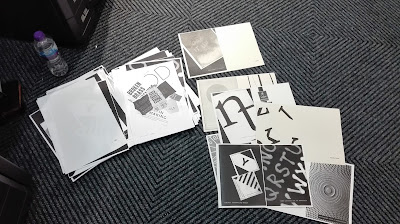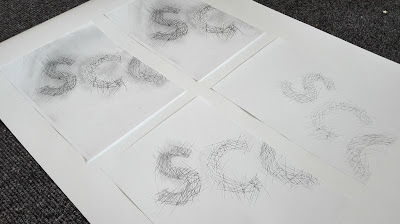Page Variations
Once the concepts for each of the pages were decided variations of the designs were tested to produce the final designs.
'Photocopy to invert' used an image from the object brief and was chosen because of the circular shape of the mark. To suggest inversion the mark would be cut in two with one half inverted to white and the other black, reflecting the contrast between the two settings. To create this part of one of the images would be collaged onto the other to produce a combined image. The designs with the mark in the top left corner will be the most effective because this will look balanced when the type is placed at the bottom of the page.
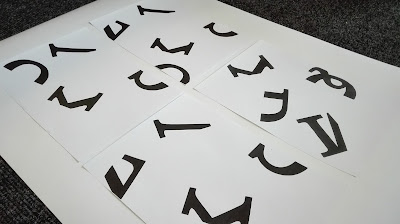
To create 'cut and rearrange letterforms' letters from the same typeface were cut up and scattered onto the photocopier. Enlarging a section of the bed meant that the letters were larger and more in keeping with the size of the imagery within the other designs. It was found that in some part of the letters e.g the Q, where the middle section had been cut out with a knife the rough edge of the cut was made obvious when enlarged. Letters that were cut using scissors were only used as this created a clean cut that was more effective when enlarged.
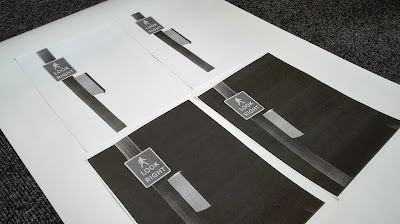
For 'photograph existing type' a picture of a sign was used as this was considered one of the most obvious sources of type. This, it was thought would make people look for more obscure sources if that was already suggested to them. It also shows that type can be found in everyday situations, all around us if the time is taken to look, providing inspiration. The sign and lamp post was cut out from an image from the wayfinding project then photocopied on a white background and with the lid up to create a dark background. The white background created the most contrast, whereas the black background seemed to blur with the image. Positioning the image on the left of the page also played with the phrase 'look right' which you would do to see the prompt in the bottom right corner of the page.
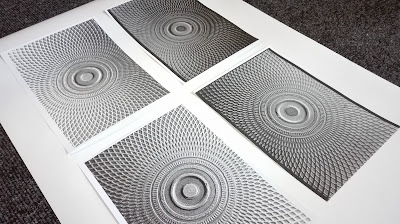
This image for 'photograph using a restriction' was taken during the object brief and could suggest a restriction of pattern, central alignment or circles. This provides a few suggestions in tackling the approach, within one image. Heightening the contrast on the design made the image stand out more, whilst inverting it created a infrared look.
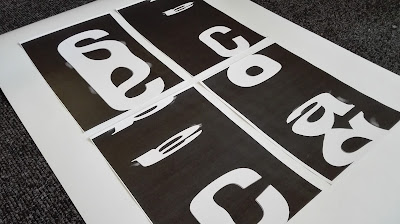
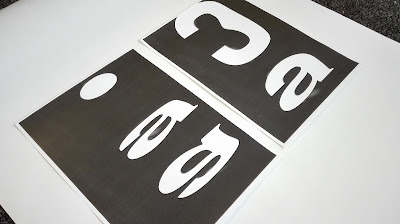
The previous experimentation for 'photocopy to distort' was not as successful as anticipated so a new set of images were created. Using an 'a' which is naturally a more distinct letterform than a 'd' led to some interesting results. It was found that if the letter was dragged backwards and forwards over the scanning bar in the same direction as it was moving, created more elongated and compact variations of the letterform, Also this allowed the merging of the letterforms which created some interesting results which were more reflective of the outcomes that could be produced with the technique. Within some of the designs however you can see where the letter has been held, so when these are used this would have to be blacked out.
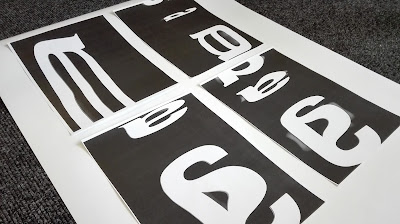
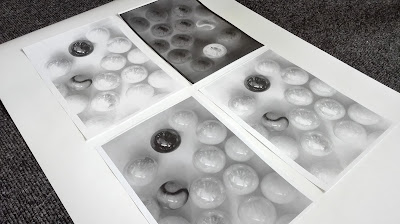
The photograph for 'find, make and photograph objects' was taken from Studio Brief 1 and shows how objects can be arranged to tell a story, The image is quite abstract allowing for interpretation and uses very accessible objects showing that simple items can communicate meaning. The design when photocopied originally didn't have much contrast so this was altered by heightening the background on the photocopier.
'Combining letterforms' uses the ligature we created in pairs. When photocopied scale was experimented with however there was still a lot of white background. To keep consistent with other designs the image was re - photocopied at an angle with the lid up to create sections of black similar to other pages.
'Make letters out of materials' uses an experiment using blue tac, from the beginning of the year. This design shows how very simple materials can be adapted to create typography. The design was initially photocopied to zoom into a singular letter however, because of the amount it had to be magnified by, meant that the design lost its sharpness. This meant a design with more letters within in was created.
'Make drawing tools' shows fragments of markmaking created with tools in the blackletter project.
For 'research definitions' and 'research synonyms' pages from the dictionary would be photocopied showing the definitions of these two words. These could be altered by drawing circles around the definitions highlighting the actual words.
To reflect 'photocopy to reduce' a letter was minimised as far as possible on the photocopier. This would then have to be re- photocopied with the lid up to create an A4 background of black.
'Photocopy to enlarge' was create using the reverse of this technique. The left design was more effective as it showed more of the characteristics of the 'G'.
'Collect interesting design' uses a symbol from some packaging. When photocopied the design was most effective with a black background as it created the greatest contrast and allowed the symbol to stand out more. The slight creased texture of the symbol has also been captured creating contrast between flat block colour and tone in the creases.
'Adapt cheap materials' uses items that can be found in stationary shops and that are inexpensive and easy to come by, whilst being versatile. When these materials were photocopied it was found that the detail within the items was emphasised by an almost glowing effect.
To reflect 'use a verb to create a letterform' this example shows how cutting into a preexisting letterform template can create a new design. The original type has become something new through the process of applying an action. To photocopy this black chalk was rubbed into the scratches to help them show up, however this also left smears which were seen in the photocopy. Inverting the design so that there was a black background meant that the background was much cleaner.
'Collage with offcuts' used found scraps which were arranged on the photocopier. The designs were most effective when on a black background as it created the greatest contrast between the elements.
'Print with found materials' uses print that was created in the wayfinding brief which created a texture using straw.
Originally an offcut of a design was going to be used for 'draw with continuous lines' however when photocopied it became pixelated. Instead different types of pens were used to create various lines. These were photocopied with increased sharpness and contrast to create crisp looking lines despite being magnified.
For 'photocopy to layer' a simple circle was photocopied once then moved and re-photocopied over the same image creating overlap in the shapes. This created quite dark image so this was inverted to show a lighter version.















